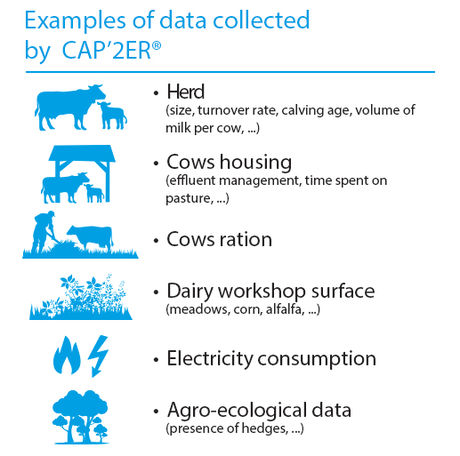The Low carbon dairy farm, an ambitious and pragmatic initiative
The Low carbon dairy farm initiative was launched by the dairy sector to support French dairy farmers wishing to reduce their greenhouse gas emissions. It is based on an individualized audit. Each farmer can then choose action levers adapted to his farm and his objectives. This approach is part of the French dairy sector’s climate change commitment. It brings together milk producers, dairy processors, cooperatives, and farm advisors.
In a few words, the Low carbon dairy farm initiative consists of :
- Carrying out a technical and economic environmental audit in each farm
- Identifying potential action levers to improve carbon footprint, technical and economic performances
- Building an action plan jointly with the dairy farmer, specific to his farm, economic and social context
- Communicating positively on the French dairy sector.
To date, more than 9 500 dairy farmers have chosen to get involved in the low carbon dairy farm. But the dairy actors wish to go far beyond involving every French dairy farm that is to say 60 000 farms. If so, around 2 million tons of CO2 could be avoided in 10 years !
The Low carbon dairy farm in 4 milestones
Since 2013, the Low carbon dairy farm initiative has grown alongside dairy farmers to reduce greenhouse gas emissions.
What is a dairy farm’s environmental audit ?

As part of a continuous improvement process, an environmental audit is a personal visit to the dairy farmer by a farm adviser, using the CAP'2ER tool. CAP’2ER is an evaluation and decision support tool. It is used to estimate the dairy farm's greenhouse gas emissions, energy consumption, but also its contribution to biodiversity, its nourishing capacity (number of people fed by the farm's production) and its carbon storage.
As first step to raise awareness on a dairy farm’s environmental impact, each farmer can self-estimate his carbon footprint by using the self-assessment tool, SelfCO2®.
What are the benefits for dairy farmers ?
Improving environmental performances is not only good for the environment. It is also guaranties farm’s sustainability. Indeed, environmental and technical-economic performances are strongly correlated. Reducing inputs, valorizing pastures, optimizing milk production ... all are ecological gestures with potential economic gains for the dairy farmer. A "win-win" strategy!
In low carbon dairy farms, regardless of the grassland system, improved environmental efficiency means better economic efficiency. Thus, the10% farms with the lowest greenhouse gas emissions have shown an average gross margin of 10 € higher per 1 000L of milk produced.
Participating in the Low-carbon dairy farm initiative also highlights the positive contributions of dairy farming. Today, the average low carbon dairy farm is:


